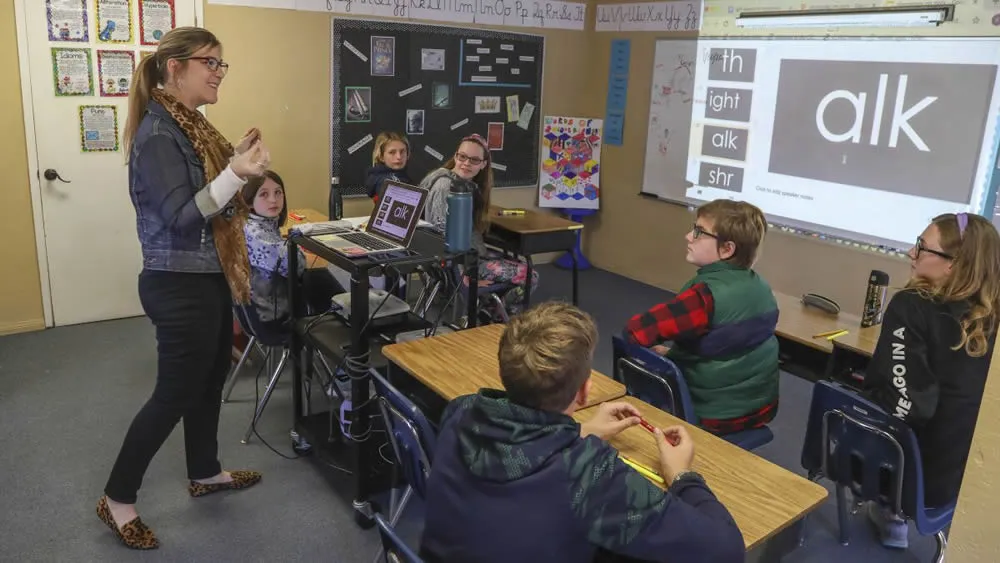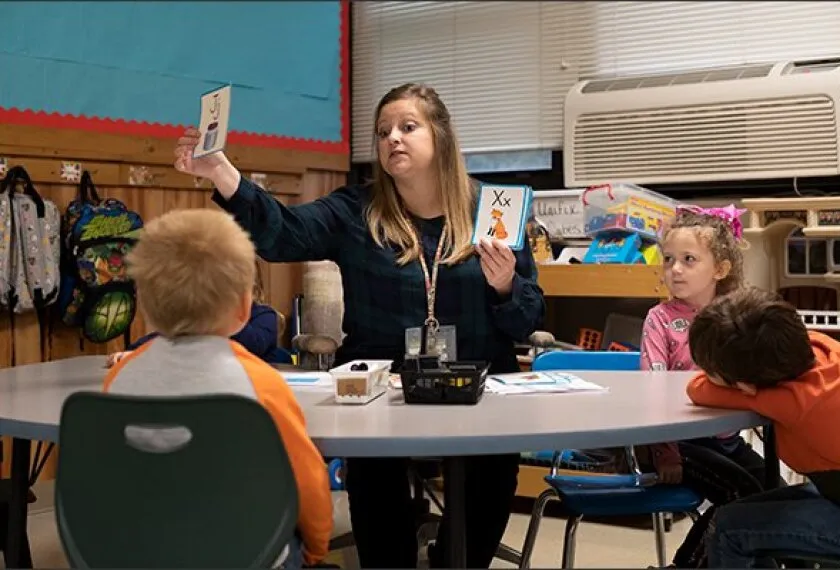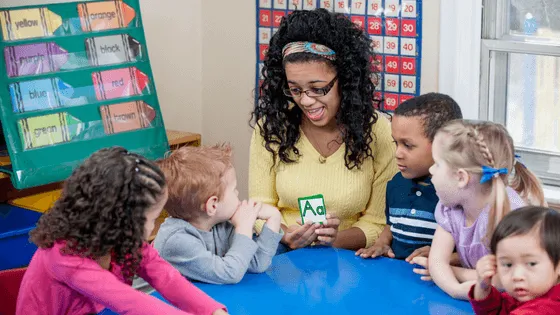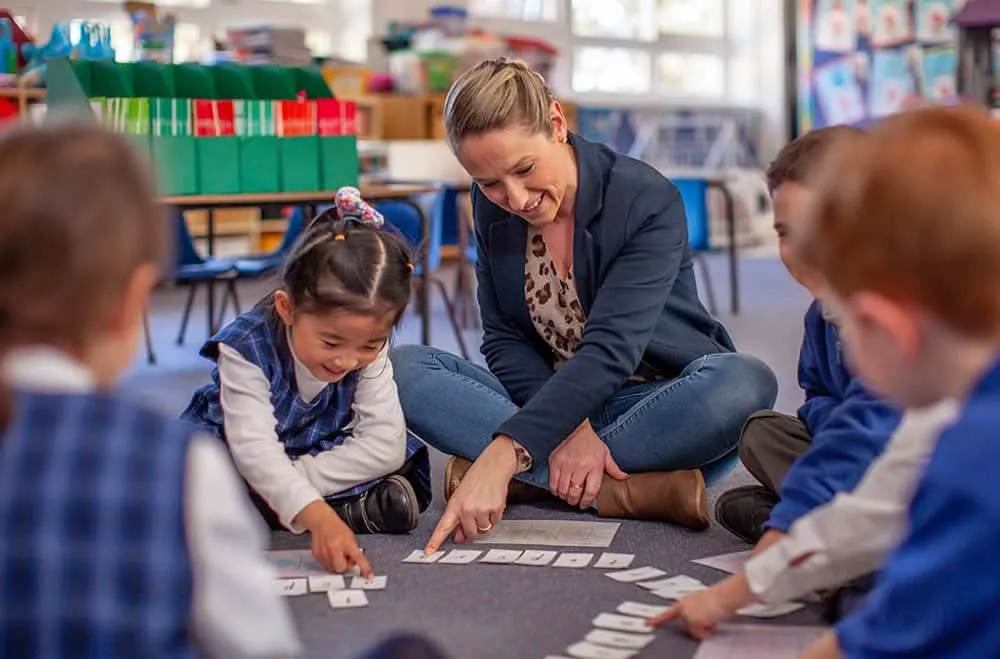How to Become Phonics Teacher?

Source: landmarkschool
How to Become Phonics Teacher?
If the question How to Become Phonics Teacher?
Is hovering on your mind then this write-up will definitely answer all your queries and encourage you to go for it!!
In order to become a Phonics Teacher, you have to first and foremost enrol in the ‘Certificate Program in Phonics Teachers’ Training’ at Vidhyanidhi Education Society (VES) and earn a certification. After which you become a certified phonics teaching professional, highly demanded in the phonics field. You can enrol without wasting time as the program runs on a loop throughout the year.
And about VES, the name itself is enough – it is one of the most well-known and time-tested teacher training institutes in the teacher training arena since over two decades now. Our alumni are placed in the most prestigious of schools and teaching institutes all over and vouch by the quality training that they received at VES.
So, the answer to the question How to Become Phonics Teacher? Lies with VES!
Table of Content
- Why is Phonics Important?
- Career Scope for Phonics Teacher
- Benefits of Phonics Teacher Training Course
- Syllabus for Phonics Teacher Training Course
- Structure of Phonics Teachers Training Course
- Duration of Phonics Teachers Training Course
- Eligibility for Phonics Teachers Training Course
- Phonics Teacher Salary
- What are alien words Phonics?
- What are the examples of Phonics?
- How to teach Phonics step by step video?
- How to teach Phonics to older students?

Source: brightspot
Why is Phonics Important?
Phonics is a language learning process that is unique and proves extremely handy when it comes to beginner language learners. Phonics is systematic. There are 42 sounds which the preschoolers are taught and then they learn to blend these sounds and read words and they break words in sounds to spell words.
Phonics is a more scientific approach to learn to read and spell as compared to traditional rote method where children had to memorise large number of word spellings or rely on pictorial clues to read.
Phonics is Important because, it has gained a lot of popularity in the last few years and is fast being adopted as a language teaching method in many schools. And so instead the requirement of phonics teachers is increasing manifold.
I am sure you are now wondering How to Become Phonics Teacher?
If you are keen to know then read on.
Career Scope for Phonics Teacher
Once you have figured out the answer to the question How to Become Phonics Teacher?
The next thought that comes to one’s mind is Career Scope for Phonics Teacher:
A certified phonics educator can –
- Start a profitable educational entrepreneurship of beginning and conducting phonics classes for children in pre-primary and primary standards. You can start immediately from home with the help of the worksheets and flashcards that we provide from VES as part of the study kit. Later you can begin a full-fledged phonics centre.
- Teach as a phonics teacher in any State / CBSE / ICSE / IGCSE / IB board school anywhere around the world.
- Get appointments like trainer, content developer, curriculum planner, lesson planner, centre-head, superviser, special needs or remedial teacher and the like.
Not only the above, a phonics educator also turns out to be a knowledgeable parent who can handle her own ward’s language learning development better.
Do you need additional information? Just dial or message us on these numbers: +9869546913 / 9869866277.
You can download the brochure by simply Clicking Here.
Benefits of Phonics Teacher Training Course
When you join VES for the ‘Certificate Program in Phonics Teachers’ Training’, we train you in How to Become Phonics Teacher?
Read the following points to find out the Benefits of Phonics Teacher Training Course at VES:
- VES a Govt. Redg Institute
- runs Offline and Online courses, Weekday and Weekend Batches.
- charges surprisingly reasonable fee.
- offers star rated and excellently reviewed learning environment.
- provides guaranteed assistance for job placements.
- bestows certification – readily accepted in the education field.
- has a fleet of the most proficient and experienced trainers.
- has phonics curriculum modelled on a well-known Synthetic Phonics Methodology from UK.
Conducts phonics teachers’ training that includes
- skill training,
- comprehensive theoretical knowledge
- rigorous practice,
- plentiful revisions,
- fruitful interactions,
- daily doubt solving,
- detailed demonstrations,
- huge study – kit including teacher’s handbook, +300 printable worksheets, +40 flashcards, handouts, audio – visual materials and teaching aids.
- gives full guidance for opening your own phonics classes.

Source: eye
Syllabus for Phonics Teacher Training Course
In order to know and understand How to Become Phonics Teacher? it will be very important to know what are the concepts you need to grasp and master as part of the Syllabus for Phonics Teacher Training Course.
The curriculum at VES covers the following concepts:
- Definition of Phonics
- Kinds of Phonic programmes
- Difference between Whole Language Approach and Phonics
- Letter sounds
- Letter Formation
- Blending
- Segmenting
- Beginning and ending consonant Blends
- Digraph sounds
- Difference between Digraphs and Blends.
- Tricky words.
- Phonics Rules
- Alternative Vowel Sounds and Spellings
Structure of Phonics Teachers Training Course
How to Become Phonics Teacher?
It is an important question and the answer to this question includes a very simple Structure of Phonics Teachers Training Course that needs to be followed:
- Call us or leave a message and we call back.
- Understand the curriculum and other important aspects of training.
- Enrol immediately.
- Attend the sessions meticulously.
- Ask doubts.
- Interact as much.
- Attempt assessment.
- Get certified.
Duration of Phonics Teachers Training Course
How to Become Phonics Teacher? in a Jiffy! Yes, you read right, roughly 18 hours is exactly the time needed or you may say six days of 3 hours Duration of Phonics Teachers Training Course each to complete training.
Eligibility for Phonics Teachers Training Course
If you possess a basic working knowledge of English and you are a
- potential teacher,
- teacher already,
- tution teacher
- businessperson in education field,
- parent,
- housewife or a
- graduate or undergraduate
and the question How to Become Phonics Teacher? is haunting you then you are most eligible for the Phonics Teacher Training course.
Do you need additional information? Just dial or message us on these numbers: +9869546913 / 9869866277.
You can download the brochure by simply Clicking Here.
Phonics Teacher Salary
The other question besides How to Become Phonics Teacher? that most aspiring teachers keep asking is – How much is Phonics Teacher Salary?
So, the answer to the second question depends upon a few factors like –
- The skill or proficiency of the appointee.
- The years of service put in by the appointee.
- The recent and past performance of the appointee.
- The location and the reputation of the school or pre-school in question.
Irrespective of the above considerations a 5-figure salary can be expected!!
Hope, your question – How to Become Phonics Teacher? is now more than satisfactorily answered and you shall soon join VES for a certification in Phonics Teachers’ Training! So, see you there!
What are alien words Phonics?
“Alien words” in the context of phonics refers to made-up or nonsense words that are used as teaching tools to help children practice decoding skills in reading.
These words do not have any meaning but follow the phonetic rules of a language. They are designed to help children focus solely on their phonics skills without relying on their memory or understanding of real words.
For example, in English phonics instruction, words like “zog,” “blip,” or “framp” might be used as alien words. These words adhere to the general phonetic rules of English but do not correspond to any real objects or concepts. The idea is to ensure that children are using their phonetic decoding skills to read the word, rather than recognizing the word by sight or context.
Using alien words in phonics instruction is somewhat controversial. Advocates argue that they are useful for isolating and testing a child’s ability to decode using phonics. Critics, however, contend that using nonsense words can be confusing for young learners and may not provide a comprehensive view of a child’s reading ability, which also involves understanding context, using sight words, and employing other strategies beyond phonetic decoding.
What are the examples of Phonics?
Phonics refers to the method of teaching reading by correlating sounds with letters or groups of letters. It is commonly employed as a technique to help children learn to read, but it can also be used to help older readers who are struggling with decoding words.
Here are some examples to illustrate various elements of phonics:
Examples of Basic Phonics Concepts
- Letter-Sound Correspondence: Learning that “a” makes the /a/ sound as in “apple,” “cat,” and “bat.”
- Consonant Blends: Learning that certain consonants blend together to create a specific sound, like “st” in “stop,” “cl” in “clap,” and “fr” in “frog.”
- Digraphs: Understanding that some letters come together to make a new, singular sound such as “sh” in “sheep,” “ch” in “chair,” and “th” in “three.”
- Vowel Sounds: Learning both short vowel sounds (a as in “cat,” e as in “bet,” i as in “hit,” o as in “pot,” u as in “cut”) and long vowel sounds (a as in “cake,” e as in “tree,” i as in “kite,” o as in “rose,” u as in “cube”).
- CVC Words: Learning to read and sound out Consonant-Vowel-Consonant words like “cat,” “dog,” and “sit.”
- CVCE Words: Consonant-Vowel-Consonant-Silent E words like “cake,” “note,” and “cube” where the silent ‘e’ makes the vowel say its name.
- Diphthongs: These are sounds made by combining two vowels in a single syllable, like “oi” in “coin,” or “ou” in “cloud.”
- R-Controlled Vowels: When a vowel is followed by an ‘r,’ it makes a unique sound, like “ar” in “car,” “er” in “her,” “ir” in “bird,” “or” in “corn,” and “ur” in “hurt.”
Do you need additional information? Just dial or message us on these numbers: +9869546913 / 9869866277.
You can download the brochure by simply Clicking Here.

Source: bridge
Examples of Phonics Activities:
- Sound Matching Games: Have children match pictures to the beginning sound of the object’s name (“apple” to “a”).
- Blending Activities: Give children phonemes (sounds) and ask them to blend them into words. For example: /c/ /a/ /t/ = “cat.”
- Segmenting Activities: Say a word like “dog,” and ask the child to segment it into individual sounds: /d/ /o/ /g/.
- Flashcards: Use flashcards to review known and newly learned letter-sound correspondences.
- Reading Decodable Books: Encourage children to read books that focus on the phonics patterns they are learning.
- Rhyming Games: Create activities where children identify rhyming words or produce words that rhyme with a given word.
- Word Families: Teach children about common word families like “-at,” “-in,” and “-op” to help them recognize patterns in words.
- Spelling Tests and Quizzes: Test knowledge of phonetic rules through spelling tests that focus on applying phonics patterns.
- Word Sorts: Sorting words based on their vowel sounds, digraphs, or other features.
- Phonics Worksheets: Worksheets often have exercises that focus on matching letters to sounds, completing words with missing letters, or segmenting sounds to spell words.
Effective phonics instruction often includes a combination of these elements, progressing from simpler to more complex skills as the learner becomes more proficient.
How to teach Phonics step by step video?
Introduction (0:00-1:00)
- Introduce Yourself: Briefly introduce yourself and explain your expertise in the field of teaching or language instruction.
- Video Objective: Clarify the purpose of the video and what the viewer will learn by the end.
The Importance of Phonics (1:01-2:00)
- Why Phonics?: Explain why phonics is essential for reading and spelling proficiency.
- Who Can Benefit: Indicate who this video is intended for (parents, teachers, tutors, etc.).
Do you need additional information? Just dial or message us on these numbers: ++919869546913 / +919869866277.
You can download the brochure by simply Clicking Here.
Basic Terminology (2:01-3:00)
- Phonemes: The smallest unit of sound.
- Graphemes: The letters that represent the sounds in written form.
- Blends: Two or more consonants that are blended together but each sound may be heard in the blend.
Preparing for the Lesson (3:01-4:00)
- Materials Needed: Mention any props or teaching aids like flashcards, whiteboard, markers, etc.
- Setting the Environment: Offer tips on creating an optimal learning environment.
Step 1: Letter Sounds (4:01-7:00)
- Introduction: Start by introducing individual letter sounds.
- Demonstration: Use visual aids to show the letter and pronounce its sound clearly.
- Interactive Session: Ask viewers to repeat the sounds after you.
Step 2: Simple Words (7:01-10:00)
- Introduction: Introduce CVC words (Consonant-Vowel-Consonant) like “cat” and “dog.”
- Demonstration: Break down the word into individual sounds and blend them together.
- Interactive Session: Have viewers try it themselves.
Step 3: Blends and Digraphs (10:01-13:00)
- Introduction: Explain what blends (e.g., “bl” in “blend”) and digraphs (e.g., “sh” in “ship”) are.
- Demonstration: Provide examples and pronounce them clearly.
- Interactive Session: Engage the audience in repeating these new forms.
Step 4: Long Vowels and Vowel Teams (13:01-16:00)
- Introduction: Introduce the concept of long vowels and vowel teams.
- Examples: Use examples to differentiate between short and long vowels.
- Interactive Session: Have viewers try some examples.
Step 5: Practice and Exercises (16:01-18:00)
- Introduction: Explain the need for practice to reinforce learning.
- Activity Suggestions: Suggest some exercises that can be done at home or in the classroom.
Conclusion (18:01-20:00)
- Summary: Recap the essential points.
- Next Steps: Discuss what viewers can look forward to in upcoming videos or lessons.
- Thank You: Thank the audience for their time and encourage them to practice regularly.

Source: multilit
How to teach Phonics to older students?
Teaching phonics to older students can be a sensitive issue. Older students may feel self-conscious about their struggles with reading, and traditional phonics lessons designed for younger children may seem childish to them.
However, mastering phonics is essential for reading fluency, so it’s important to approach the subject in an age-appropriate and engaging way.
Here are some tips on teaching phonics to older students:
Assessment and Identification
- Initial Assessment: Before you begin instruction, perform a thorough assessment to identify the specific phonics skills that the student lacks.
- Target Skills: Focus on the areas that need the most improvement rather than following a one-size-fits-all curriculum.
Age-Appropriate Materials
- Use Mature Themes: Select reading materials that are age-appropriate in terms of content and interest level but tailored to the reading ability of the student.
- Avoid Juvenile Content: Older students might feel demeaned by materials designed for younger learners. Use resources geared toward adults or create your own.
Instructional Techniques
- Explicit Instruction: Teach phonics rules explicitly, and show how they apply to real reading and spelling tasks.
- Multi-Sensory Techniques: Use visual aids, manipulatives, and movement-based activities to appeal to various learning styles.
- Contextualize: Teach phonics in the context of meaningful texts whenever possible. This shows the practical application and relevance of the skills.
Make it Relevant
- Connect to Real Life: Show how good phonics skills are used in everyday activities like reading newspapers, filling out job applications, or understanding manuals.
- Use Technology: Apps, games, and online programs can provide older students with the opportunity to practice their skills in a more engaging way.
Confidence Building and Motivation
- Immediate Feedback: Offer immediate, constructive feedback to help students correct mistakes as they happen.
- Celebrate Successes: Positive reinforcement can help build confidence, which is often a significant barrier to learning for older students who have struggled with reading.
- Set Achievable Goals: Create short-term goals that are achievable but still challenging. The sense of accomplishment from meeting these goals can be highly motivating.
Practice and Application
- Guided Practice: Work through examples together before setting independent practice tasks.
- Application Tasks: Assign tasks that require the student to apply what they have learned, such as reading a newspaper article or writing a short essay.
Flexibility and Review
- Ongoing Assessment: Continuously assess the student’s understanding and mastery of skills and be ready to adjust your teaching approach accordingly.
- Review and Reinforcement: Older students might have gaps in their foundational knowledge, making regular review and reinforcement crucial.
Remember that older students may require more time to overcome their initial resistance or lack of confidence. Patience, positivity, and a respectful approach are key to helping older students master phonics.
How to Become Phonics Teacher?
Unlock a world of literacy—Join Vidhyanidhi’s Phonics Teacher Training today!
Do you need additional information? Just dial or message us on these numbers: ++919869546913 / +919869866277.
You can download the brochure by simply Clicking Here.
FAQ
How to become a certified phonics teacher?
To become a certified phonics teacher, you often need to complete a specialized course from a reputable organization like VES, followed by an assessment or exam.
How do I teach phonics?
Teaching phonics involves breaking down words into their individual sounds. Use activities, flashcards, and games to help kids connect sounds to letters.
What is whole language learning?
Whole language learning focuses on understanding language as a complete system. Instead of phonetic breakdowns, it emphasizes context, meaning, and natural usage.




